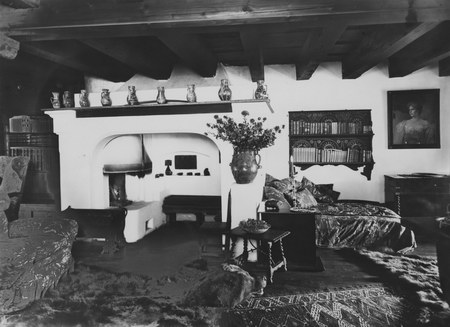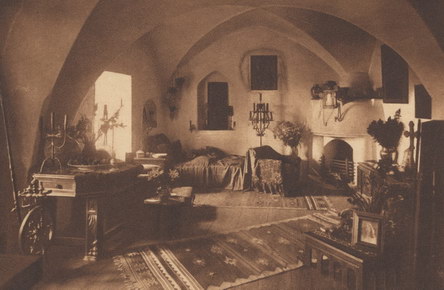Exhibition presentation
About the exhibition
The story of the one who would become Queen Maria of Romania (1875 – 1938), one of the most fascinating personalities of her era, still impresses today.
Maria was the eldest daughter of Duke Alfred of Edinburgh (the second son of Queen Victoria of Great Britain and Prince Alfred of Saxe-Coburg-Gotha) and Grand Duchess Maria Alexandrovna of Russia (daughter of Tsar Alexander II and Maria Alexandrovna). Around the age of 11, she moved with her family to the island of Malta, a Mediterranean paradise, where people were so smiling, natural, and natural, in contrast to the cold and distant nature of the British. It is likely that from this period a strong sense of freedom of thought and a strong romanticism developed in the young woman's soul. Maria, nicknamed Missy, would imperceptibly leave the age of innocence and gracefully move into adolescence. She was already being talked about as the most beautiful princess in Europe.
Her marriage to the Crown Prince Ferdinand of Romania (1865-1927), in 1893, a brilliant alliance, would raise the prestige of the young Romanian state. Through her work as a Red Cross nurse during the Balkan and Unification Wars, as well as through her charity and patronage, Queen Maria became a symbol for the Romanian nation.

The largest room of Bran Castle,
Queen Mary's music room and library,
was arranged in an old bridge of the fortress,
according to the plans of the chief architect of the Royal Court, Karel Liman.
Talented and spontaneous beyond all that the label imposed by her noble rank meant, Maria was called at the time, “the queen artist”, being at the same time a painter, photographer, interior designer, and above all, a writer. In her literary activity she approached the memoir genre, the essay, children's literature, and also wrote articles for prestigious American magazines. She made her debut in 1915, with the volume of stories, “The Dreamer of Dreams”, culminating in her work of recognized documentary value, “The Story of My Life”.
A nonconformist by nature, she opposed the sobriety and etiquette of King Carol I from the very beginning, gradually trying to arrange the interiors of her residences according to her own artistic taste. The alternative to the grandiloquent and official style of the young Romanian monarchy would materialize in what she herself called, in an article from 1935, “my dream houses”, because all the queen’s dreams were directed – as she confessed – “towards country cottages, light, Indian shelters, towards buildings unimaginable by the few, with thatched roofs and surrounded by gardens, in which all kinds of flowers would grow in abundance”.
The castles dear to her soul, Pelişor, Bran, the wonderful summer residences in Balchik, Copăceni and Mamaia, the little house among the fir trees in Sinaia, (Juniperus), or the Maori huts in Cotroceni and in the Pelişor garden were also places of refuge, of romantic dreams, with a fragrance of the era, but also precious evidence of the interior design style from the beginning of the 20th century.
The exhibition "Queen Maria's Dream Houses - Bran Castle" is organized in collaboration with the Bran National Museum.
The architect of the modifications of the living spaces at Bran Castle (after 1920), Karel Liman, is the author of the project of the last stage of construction of Peleş and the holder of the erection of Pelişor Castle (1899). This artistic argument makes an inseparable link between the two royal residences, so closely linked to the destiny of Queen Maria.
About 120 cultural assets belonging to the Queen's Music Salon are exhibited for the first time at Peleş, of which we highlight an exceptional musical instrument, a harmonium, made by the J. Trayser & Co workshops in Stuttgart. The German workshops, specialized in designing musical instruments, received numerous awards and gold medals for this curious "piano", similar to an organ, at European industrial exhibitions, including Munich and Paris, in 1865. Maria's bedroom, with furniture made at the sovereign's request, of which the neo-Brâncovenesque armchair with the motif of the double-headed eagle, the divan covered with decorative pillows, but especially the table coverlet, embroidered with Art Nouveau floral decoration in polychrome silk, all these pieces will recreate the "Romanian room" designed in the 1920s.

The bedroom is described by Queen Mary, in the smallest details: I slept wonderfully in the lovely little bedroom which I love, with its low vaulted ceiling, its deep-arched windows, its beautiful blue Chinese carpet, its fantastic old icons, its embroidery, its rustic furniture and its peculiar carved woodwork, its interesting specimens of old earthenware and silverware, its two perforated windows in Greek marble, its peculiarly shaped fireplace, which warms so well, and my beautiful wooden monk on his old stone pedestal, on the capital of a column, who watches over everything. There could not be a more harmonious and unusual little room. My bed is spacious and comfortable, low, simply a huge box spring with the mattress on the floor. At the head of the bed I have placed a beautiful inlaid headboard, which I have from the British Museum, a piece of Indian sculpture. During the day, a wonderful old Italian quilt, embroidered all over in pale colors, on a brown and gold background, covers the bed which becomes a sofa filled with velvet cushions in pale tones, which harmonize perfectly with the rest. On the wall at the head of the bed is a small niche, where there is an old icon of the Virgin (a small triptych) and a collection of small books. This wonderful room is wide and you reach it by climbing several stairs and passing through a double entrance.
The Doria salon at Bran Castle will not be missing the four-poster bed of Admiral Giovanni Andrea Doria, a piece of exceptional value from the 16th century, belonging to the art collection of King Carol I. Having been in the textile restoration laboratories of MNPeleş for several years, for works of consolidation and restoration of the embroidery and silk panels, this Genoese masterpiece will be exhibited to the visiting public for the first time.
The decorative art pieces chosen by Maria to enliven the rooms of Bran Castle, the copper câche-pots, once filled with her favorite flowers, her own creations in the field of furniture design, her preference for Romanian motifs in the field of textile art and ceramics will be reunited in the exhibition halls. The warm and intimate atmosphere of the interiors is completed by statuettes carved in painted wood, books, incense burners, candles, a valuable tetrapod, a collection of icons painted on wood among which stands out a work, “The Bishop”, from the 15th century, purchased by Queen Maria from Paris, fittings and pieces of furniture, made in the neo-Romanian style. Queen Maria's style cannot be framed in a common artistic pattern, because her imagination, coupled with the multiple stylistic influences found in the early 20th century in specialized magazines, created an interesting interweaving of Eastern Byzantine elements, local architectural and ethnographic motifs, as well as certain Ottoman art models and even ancient, Celtic motifs.
The heritage of exceptional artistic and memorial value located in the royal rooms at Bran is completed with pieces of furniture made of burnt fir, commissioned from architect Karel Liman for the tea house in the castle garden, thus completing "that nameless something", incomparable and inimitable which is "Queen Maria's style".
Exhibition opening
TVR report
Promo 1
Promo 2
Visiting the Exhibition
The exhibition was visited during:
April 28 – August 26, 2012.